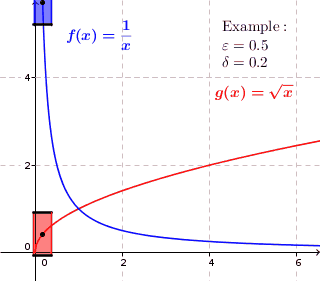What is the geometrical difference between continuity and uniform continuity?
Here is how I see it:

Continuity is about for each given point to find proportions of a window $$ \mathrm{height}\times \mathrm{width}=2\varepsilon\times 2\delta $$ such that the graph passes through the sides, not the top or bottom. Or to be more precise, no points on the curve lie directly above or below the window.
Pointwise: A curve is pointwise continuous, if at each point it is possible for any given height $2\varepsilon$ to adjust the width $2\delta$ so that the curve passes through the sides of the window. Again, no points must lie directly above or below.
Uniform: A curve is uniformly continuous, if it for any given height $2\varepsilon$ is possible to find a width $2\delta$ of a window that works for the entire curve.
As you can see, the blue window works only for the lower part of the curve, whereas the red window works for the entire curve. Since this will be true for any given window height $2\varepsilon$, however small the width, the blue curve is NOT uniformly continuous. For the red curve, it is always possible to adjust the width $2\delta$ (make it small enough) so that the window will work for the entire curve.
Higher dimensions: For functions $F:\mathbb R^n\to\mathbb R$ with graphs in $\mathbb R^{n+1}$ and $y=F(x)$, replace the notion of a window with the notion of a cylinder: $\mathcal B_{\delta}(x)\times(y+[-\varepsilon,\varepsilon])$. Then no points must lie "above" or "below" that cylinder, in the sense that no point with its first $n$ coordinates contained in the first ball must lie outside the interval specified in the last coordinate.
And for $G:\mathbb R^n\to\mathbb R^m$ having $y=G(x)$ use a product of balls $\mathcal B_{\delta}(x)\times\mathcal B_{\varepsilon}(y)\subseteq\mathbb R^{n+m}$. Here no points with the first $n$ coordinates contained in the first ball must have the last $m$ coordinates escaping the second ball.
$\newcommand{\Reals}{\mathbf{R}}$Here's my "secret weapon" for detecting uniform continuity visually:
If $E$ is a bounded, non-empty set of real numbers and $f:E \to \Reals$ is a continuous function, then $f$ is uniformly continuous if and only if there exists a continuous extension $\overline{f}:\overline{E} \to \Reals$. (This assertion is true in much greater generality, e.g., if $E$ is a totally bounded, non-empty subset of a complete metric space. I'd say this theorem alone provides adequate justification for considering the concept of uniform continuity. :)
It follows at once that the following bounded functions are not uniformly continuous on the set $E = \Reals \setminus\{0\}$ of non-zero real numbers, but are uniformly continuous on $\Reals \setminus [-\delta, \delta]$ for every $\delta > 0$: $$ f(x) = \sin(1/x);\qquad g(x) = x/|x|. $$ The fact that $g$ is locally constant (vanishing derivative throughout its domain) highlights the global, domain-dependent nature of uniform continuity.
Similarly, if $\phi$ is continuous on $\Reals$ and $\phi(x) \to 0$ as $x \to 0$, then for every positive integer $k$, the function $h(x) = \phi(x) \sin(1/x^{k})$ is uniformly continuous on $(-1, 0) \cup (0, 1)$. (Setting $h(0) = 0$ defines a continuous extension; you can't make the sine factor oscillate rapidly enough to spoil this, no matter how "slowly" $|\phi|$ decays near $0$.)
For similar reasons, the polar angle function $\theta$ is not uniformly continuous on the plane with the closed unit disk and negative horizontal axis removed, even though the domain is connected and the gradient has bounded magnitude. (The angle $\theta$ "wants" to take both values $\pm\pi$ along the negative horizontal axis, so there's no continuous extension to the closure.)
Consider the graph $y=f(x)$ of a function $f:{\mathbb R}\to{\mathbb R}$ and an arbitrarily thin "$\>\epsilon$-hose" $$F_\epsilon:=\bigl\{(x,y)\>\bigm|\> |y-f(x)|<\epsilon\bigr\},\qquad \epsilon>0,$$ around it. If $f$ is uniformly continuous then there is a $\delta>0$ such that all horizontally translated graphs $y=f_h(x):=f(x-h)$ with $|h|<\delta$ will fit into $F_\epsilon$.
If $f$ is not uniformly continuous then for some (whence for all suitably small) $\epsilon>0$ and all $n$ there are two points $x$, $x'$ with $|x-x'|<{1\over n}$ and $|f(x)-f(x')|\geq\epsilon$. It follows that any graph $f_h$ with $|h|>0$ will transcend the boundary of $F_\epsilon$ somewhere.